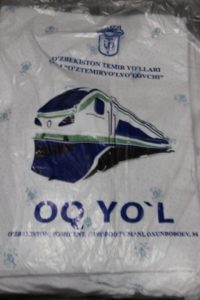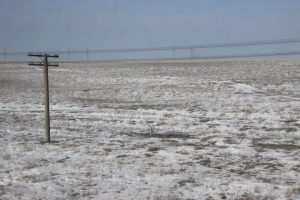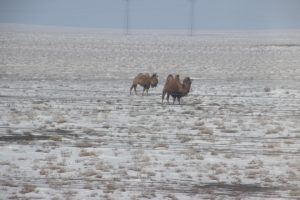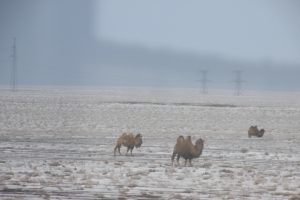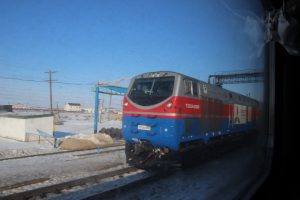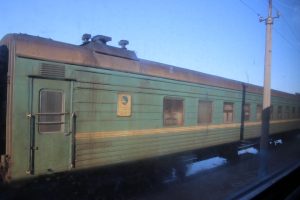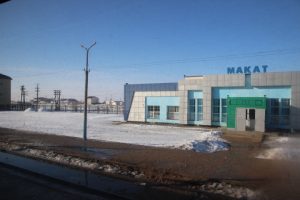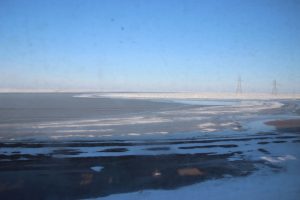We left Volgograd at 19:59 yesterday by train and have so far travelled down the Volga River valley towards its delta and the Caspian Sea. North of Astrakhan at Aksaraiskaya at 02:25 this morning we arrived at the Russian border. Here immigration and customs formalities take place on the train and for more than 2 hours one just has to wait. By 04:45 we were on our way to Ganyushkino in Kazakhstan. This is 87km further east so the train is sealed and one travels through a no-man’s land until the next set of formalities are completed. We arrived at the border post at 06:09 Moscow time but Kazakhstan operates on GMT+6 so here it was 09:09. We were finally on our way at 10:55. It is difficult to relate much about the next 200km as we were asleep!
The fresh bed linen is supplied in a sealed bag.
When we reached Atyrau we were at the northeast end of the Caspian Sea where, from a small port on the near horizon, ferries cross to Tblisi. Further east at Dossor the snow was really deep, wind blasted and formed into miniature dune like shapes of different lengths extending to the horizon. This is the Steppe – a scrub like grassland that extends around the world at this longitude but because of its experience of continentality the cold and the snow is more extreme.
Dossor is the gateway to the Russian space project. We could see from the train that entry points to the town were signalled by signs in the shape of a 1960s rocket. The Baykonur Cosmodrome is an area of some 6000 square kilometres of this semi desert and a couple of hundred kilometres from this town. Visits are possible but advance permission is needed and on an expedition like this is not possible. One of the reasons for the remoteness is possibility security but in reality the Russians need the space for returning cosmonauts to land because they land on the surface of the earth and not in the ocean as the Americans do. Kazakhstan was originally a Russian Republic when the space programme began.
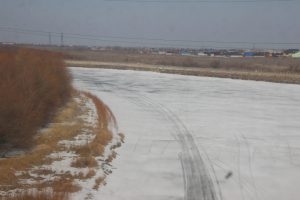

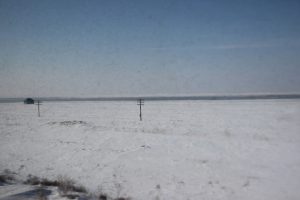
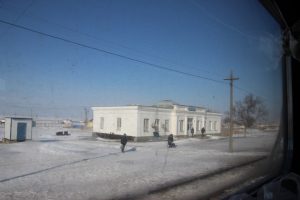
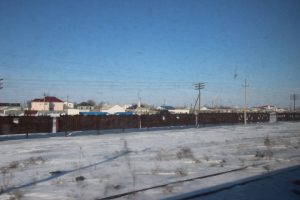
We have also here crossed the ‘Ural line’, a line extending southwards from the Ural Mountains, and are now geographically in Asia.
We continued to make good time to Makat where the train was serviced and 40 minutes later we were travelling through the marshlands of the northeast part of the Caspian Sea.
These lakes were frozen but the further southeast we travelled the less snow was present but there was evidence of salinisation as the summer heat and a possible lack of rainfall is turning the lakes into salt pans (in miniature this is the same way as Death Valley and the Jordan Valley near the Dead Sea have formed). Onwards we went and by 23:21 we arrived at our next international border at Beineu Granitsa. If anyone was sleeping you certainly knew one had arrived at this important place because the provodnik works his way down the carriage opening compartment doors and letting everyone know that you have to be wide awake and seated to await the soldiers and officials who will inspect passports, visas and luggage. By 01:24 formalities were complete and we were on our way in a southeasterly direction, again sealed for the 98 km journey to the Uzbekistan border post at Karakalpakya where we arrived at 03:00. Uzbekistan operates on GMT+5 so our clocks go back one hour so it is 02:00 here. By 05:00 we are on the move again.
